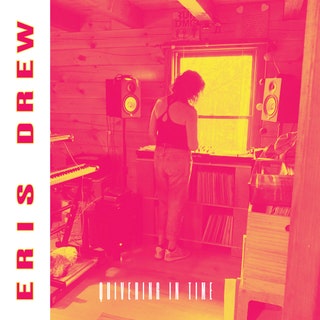Born of impromptu DJ sets broadcast from a forest clearing in New Hampshire, Drew’s latest album distills decades of dance-music history into an hour of joyous new standards.
Last year, when COVID-19 shut down the record stores and clubs and raves, along with the rest of the Western world, Eris Drew went to the woods. The past few years had been an epic come-up. In the 1990s, Drew found her footing in the vast DIY network of Midwestern raves, which amalgamated the West Coast scene’s psychedelia and the East Coast’s need for speed into a hearty, industrious underground. She began mixing records as a teenager, eventually developing an ecstatic style full of turntable tricks and fueled by the pleasure principle. An occult encounter driving home after a rave gave her access to the “motherbeat,” a feminine pressure which her exuberant DJ skills translated into blends of breaks, hardcore, house, and techno for the ravers.
In 2012, at Chicago’s legendary Smart Bar, Drew and some friends started Hugo Ball, a party she later called a “polysexual, oppositional surrealist happening.” It was a hit. She transitioned and renamed herself Eris, after the Greek goddess of chaos, and met her partner in love and life and work, Octo Octa. The two began DJing B2B sets around the world, turntables up on cinder blocks, testing the limits of themselves and their soundsystems. They started a label, T4T LUV NRG, to control their own destiny. Drew put out 2019’s gloriously self-explanatory Raving Disco Breaks Vol. 1 and 2020’s Fluids of Emotion EP, a demonstration of breaks as emotional breakthroughs. The pair offered a jubilant mix for the Fabric series that freshened up styles of progressive house and hardcore the techno intelligencia had long dismissed as passé but dancers knew still worked. And then the pandemic arrived. Drew and Octo Octa and their loving partner Q found a cabin in New Hampshire, rigged up a studio in it, and built a life of love and occasional DJ sets transmitted in a clearing via YouTube. Quivering in Time came from those forest moments. Anticipated for decades, apparently made in just a few months, the album is an instant party-starter and a statement of intent. It threads together the last 40 years of dance music into a solid hour of new standards.
“Time to Move Close” kicks things off like an affectionate pat on the back that pushes you onto the floor. The beat shuffles, the bass thumps, and as it settles into itself, Drew begins lacing in samples of cut-up vocals and sound effects that glint like confetti caught in strobe lights. “Loving Clav” deepens the hypnotism with runs on the titular keyboard tumbling over fat acid basslines and clarion melodies like trumpets on arrival. And from there, Quivering really takes off, blurring genres and bringing delight with each backspin, each breakdown, each moment where a track almost trainwrecks upon itself and, instead, takes flight. The decades Drew spent deep in the mix inform the breadth of samples she deploys: Moments of “Pick ‘Em Up” suggest that she’s queued up a dozen amazing record stores’ stock and is cutting like a maniac between it all. The music sounds like it was as much fun to make as it is to dance to. But it’s really about showing up, not showing off. Album highlight “Show U Love” is also chockablock with sampled classics, but the feeling is like bumping into one old friend after the other in the club—and the ones you don’t recognize become treasured, too. The title track is similarly, consciously amiable, too, an invocation of tenuous bliss.
Other tracks feel especially present through a kind of time travel. “Sensation” begins as a rosy, mid-tempo chugger; after a quick swell that teases the onset of a piano-house banger, Drew instead drops the tempo as if drawing back a record from 45 to 33 rpm to reveal a foggy, after-hours chiller. Seconds later, the track is back up and running for another funky minute or two. It’s an entire set, a full night in four and half minutes, and it ends with a triumphant holler.
Drew’s most audacious move might be recasting one of the most beloved bits of dialogue in rave history: Frank Maxwell and Peter Fonda’s hedonistic vow, “We wanna be free to do what we want to do… and we wanna get loaded!,” from the film The Wild Angels, immortalized by Primal Scream and the late, great Andrew Weatherall for their anthem “Loaded.” Her “Ride Free” distills the festival-sized Madchester classic into something human-scaled, powered by simple, church-y organ and a faithful drum loop or two. It’s a reminder that rave, like any world-changing movement, is rooted in just being in a room together at the same time. Drew tempers Fonda’s infectious, macho bluster with a female voice that spells out a mission: “Somehow, individually we have to reclaim our experience… the primacy of direct experience, that as people the real universe is within your reach always.” For Eris Drew, the time is now.



0 comments:
Post a Comment